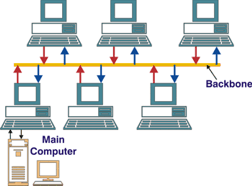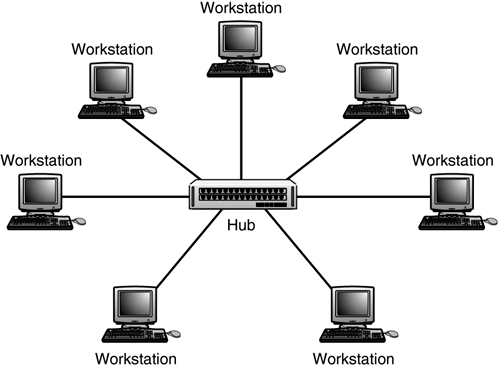The configuration of a network that consists of cables, computers, and other peripherals.
It describes the physical and logical layout of the network.
What is a physical topology?
The physical topology of a network refers to the configuration of cables, computers, and other peripherals.
What is a logical topology?
The logical topology of a network refers to the architecture, that is the way in which the network appears to the devices that use it.
Three (3) basic types of network topology:
1. Star Network.
2. Bus Network.
3. Ring Network.



Bus Network Topology Ring Network Topology Star Network Topology
A bus network
consists of a single central cable (backbone/trunk), to which all computers and
other devices connect (node
The bus is the physical cable that connects the computers and other devices.

Logical Topology
- The bus in a bus network transmit data, instructions,
and information as a series of signal.
- Those signals are sent as electrical pulses that
travel along the length of the cable in both directions.
Each devices is connected to the single bus cable through T-Connector. A terminator is required at each end of the bus cable to prevent the signal from bouncing back and forth on the bus cable.
How its work -
When a sending
device transmits data, the address of the receiving device is
included with the transmission.
If the device
address does not match the intended address for the data, the device ignores the data.
If the data does match the device address, the
data is accepted.
All devices receive the data but only the receiving device accept them.
Ring Topology
Physical Topology
On a ring network, a cable forms a closed loop (ring) with all computers and devices arranged along the ring.
Data transmitted on a ring
network travels from device to device around the entire ring, in one direction (clockwise
or counterclockwise).
Token passing is one method for sending data around a ring.
Each device takes a turn sending and receiving information through the use of a token.
How its work -
The token along with
any data is sent from the
first device to the second device which
extracts the
data addressed to it and adds any data it
wishes
to send
Then second device passes the token and data
to
the third device, etc. until it comes back
around to
the first device again.
Only the device with the token is allowed to
send
data . All other devices must wait for the
token to
come to them.
All the computers
and other devices on the
Physical Topology
Two types of devices that provide a common

Logical Topology
All data that transfers
from one device to another passes
through the hub or switch
If the network used hub data will transmit the nodes to all port , if used the switch only to the intended reciepant.
| Network Topology |
Advantage |
Disadvantage |
| Bus Topology |
1. Bus networks are
inexpensive and easy to install. 2. Computers and other
devices can be attached 3. Failure of one device
usually does not affect the |
1. There might be
disruption when computer or 2. Because all systems on
the network connect to 3. It is difficult to
identify the problem if the entire network shut down . |
| Ring Topology |
1. The transmission of data
is relatively simple as packets travel in one direction
only. 2. Cable faults are easily
located, making
3. The uses of token passing enables all devices in |
1. A failure in any cable
or device breaks the 2. Data packets must pass
through every computer |
| Star Topology |
1. If one device fails,
only that device is affected. 2. Devices can be added to
or removed from |
1. If the hub or switch
fails, the entire network will 2. Requires more cable than
most of the other 3. More expensive because
of the cost of the |